When it comes to content strategy, different types of content are the different tools in your toolbox. You have to know when and how to use each one, otherwise, you’ll try to hammer a nail with a screwdriver.
This piece acts as a complete reference guide to the types of content at your disposal for constructing the content strategy for your online store. Each entry includes a description, a list of advantages, some best practices, and a telltale example.
Think of this guide as a quick-reference catalog for different types of content, to help make sure you always make the best choice for whatever your content strategy calls for.Table of Contents
- 1 #1. Blogs and Articles
- 2 #2. Buying Guides
- 3 #3. Webinars
- 4 #4. Lookbooks (Product Image Galleries)
- 5 #5. Social Media
- 6 #6. Videos
- 7 #7. Podcasts
- 8 #8. Infographics
- 9 #9 Expert Roundups for eCommerce
- 10 #10. Email Marketing
- 11 #11 Interactive content: Quizzes, Polls
- 12 #12. FAQ pages
- 13 #13. Glossaries & Dictionaries
- 14 #14. User-generated content
- 15 Conclusion
#1. Blogs and Articles
The most popular and versatile type of content, blogs, and articles are like the gold standard for content.
They can be used at almost any stage of the sales funnel and can range from informative to strictly entertaining. You can even guest-post your blog posts on other sites to spread your brand to new audiences.
Blogs can cover a variety of formats: breaking news posts, how-to guides, references guides, and even editorials or opinion pieces. Because they can be so informative, blogs are a great way to establish yourself an authority on your niche, as we explained in How to Apply Content Strategy to Each Stage of the Sales Funnel.
![Must Read Books For Every eCommerce Entrepreneur [+ Video Summaries]](https://monetize.info/wp-content/uploads/2020/08/Must-Read-Books-For-Every-eCommerce-Entrepreneur-Video-Summaries.webp)
According to a Writtent list of statistics, companies that blog have an average of 434% more indexed pages. The same page also cited that blogs that post daily also get five times more traffic than blogs that post weekly or less.
Blog Posts Advantages
- Versatile — any format or tone
- Can be repurposed to other formats like Webinars, videos or infographics
- Boost SEO
- Frequent informative blogs on your niche establish you as an authority
- Guest posts get your name to new audiences and improve SEO (despite the critics, online marketing expert Neil Patel still supports guest blogging)
- Produce 67% more leads on average than sites without blogs.
- Provides shoppers with information that encourages a sale.
Blog Posts Challenges
- You need to post content regularly.
- The content needs to be well researched.
- You need to do experiments to find the right tone, content length (too much will not be read, too thin it will not be picked up by Google) and the number of images your audience consumes.
- It is not suitable for all niches and audiences (especially younger ones who prefer video).
Blog Post Best Practices
- Short paragraphs. A blog with lengthy blocks of text looks intimidating and can scare off readers before they even give it a chance. Pauline Cabrera gives 10 compelling reasons to keep blog paragraphs short.
- Catchy titles. Often, users will decide whether or not to read a blog based on its title, especially if the title is the only information they have. Blog title writing is a skill in itself, with its own best practices.
- Images. A page filled completely with text can be boring, so it’s best to break up the monotony with images. These images can also help with SEO, as long as they’re tagged properly.
- Post regularly. Posting on a regular schedule creates a rhythm and encourages visitors to check back more frequently. Posting irregularly or infrequently annoys fans of your blog. Learn to keep a set publishing schedule.
Blog Post Example
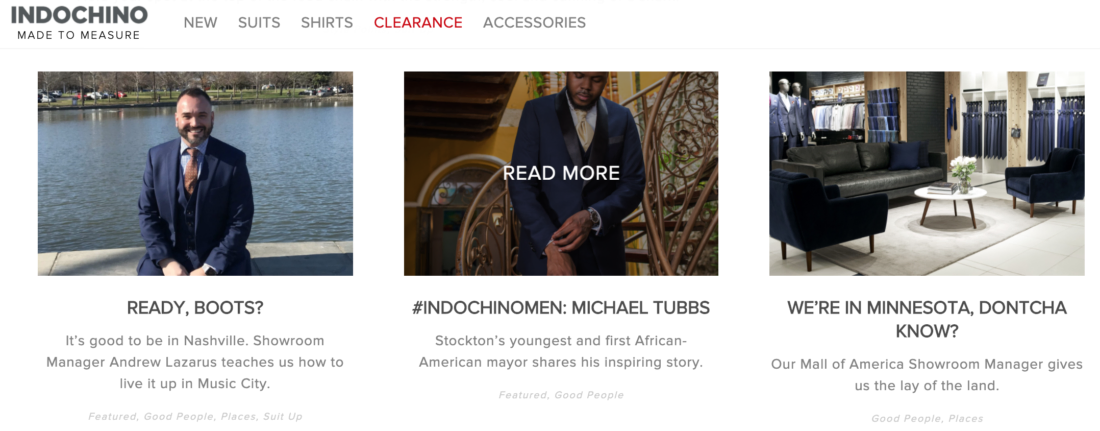
The men’s clothing retailer, Indochino uses their blog to establish themselves as an authority on men’s fashion. Among their topics are style advice, shopping advice, and fun quiz-like posts related to both fashion and James Bond, another popular topic among their target shopper.
More articles on blog posts content creation:
#2. Buying Guides
Buying guides are content that answers the most commonly asked questions about buying a product or type of product. They can be written in a blog format and also as comparison charts or pricing charts.
They are especially useful to eCommerce sites, as they attract new shoppers looking for assistance, establish authority on the topic, and usher shoppers further along the sales funnel.
Buying Guides Advantages
- Uses links to direct shoppers straight to the product page.
- Establishes you as an authority.
- Provides users with the information they need to complete a purchase.
- Keeps users on-site while they research.
- Attracts new shoppers searching for information.
- Promotes products that shoppers may not know about.
Buying Guides Challenges
- Needs a lot of research to be done.
- Need a lot of time to actually research the products.
- It is not suitable for all niches and audiences (especially younger ones who prefer video content).
Buying Guides Best Practices
- Know what your shoppers are looking for. To decide what to include in your buying guide, discover what information your users want to know before making a purchase. Conduct some research of your own through user testing, interviews, or search engine research.
- Target “inquisitive” SEO keywords. Buying guides are great for attracting new shoppers. Target keywords that potential customers are searching for and then provide them with that information.
Buying Guides Example
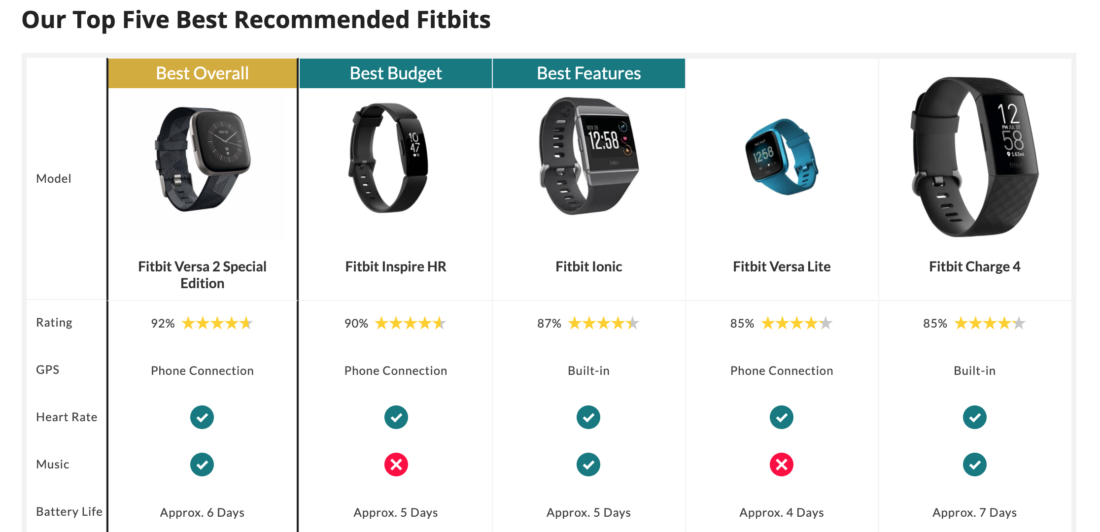
As an Amazon affiliate, the fitness site Wear Action shares some of the profits from any sales they direct there. With their Fitbit comparison chart, they’re able to quickly answer shoppers’ questions through a visual aid and send them straight to the product page with a single click.
#3. Webinars
Webinars have become one of today’s most important and productive tools for lead generation, pipeline acceleration, and the education of customers and prospects. As more and more marketers rely on webinars to engage with their customers, competition for the time and attention of those customers intensifies.
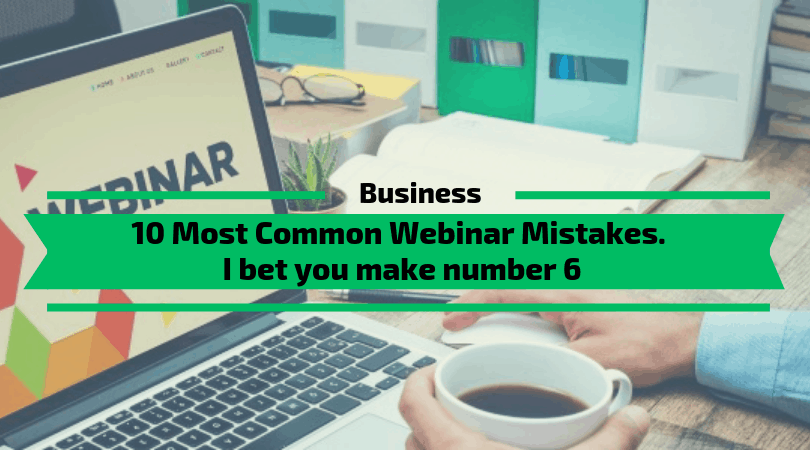
Webinars are highly effective marketing and sales tools for any level of the sales process. For example, webinars attract large numbers of leads for the top of your funnel; they are also an incredible way to scale the efforts of your sales team to close sales at the end of your sales process.
Webinars Advantages
- Build brand authority and trust fast.
- Easy and convenient to both presenters and participants.
- Generate sales leads.
- Launch and promote new products.
- Educate and interact with your customers.
Webinars Challenges
- If you don’t have a big followers base you need to pay for content promotion.
- Technical difficulties may appear as users use different operating systems and devices, audio-video configurations, etc.
- There is a lot of time involved to research what your audience wants (length, angle, level of information, etc)
Webinars Best Practices
- Keep the event exciting and relevant. Outline what you will be discussing during the event, and in what order. Make it clear that people will leave with actionable advice and recommendations. Engage your audience from the beginning they join the event. Also as webinars are quite the new things, that got way more traction during COVID19 pandemic so you should explain to the audience how the technology works.
- Make sure the event is interactive. Upload a PowerPoint or Prezi presentation, share a video, navigate through the website to engage attendees. Use slides to illustrate your points, not as a visual crutch—and don’t simply read content from the deck. Also consider allowing participants to ask questions during the event itself, rather than during a specific time period in the end.
Webinars for eCommerce Example
Printful is a drop shipping company that offers printing, dropshipping, and fulfillment services for clothing items, accessories, and homewares. They print your custom-made designs onto any of the items they offer and then they ship your products directly to your customers that you can integrate with your own eCommerce platform.
They offer a series of webinars that help their customers to sell more.
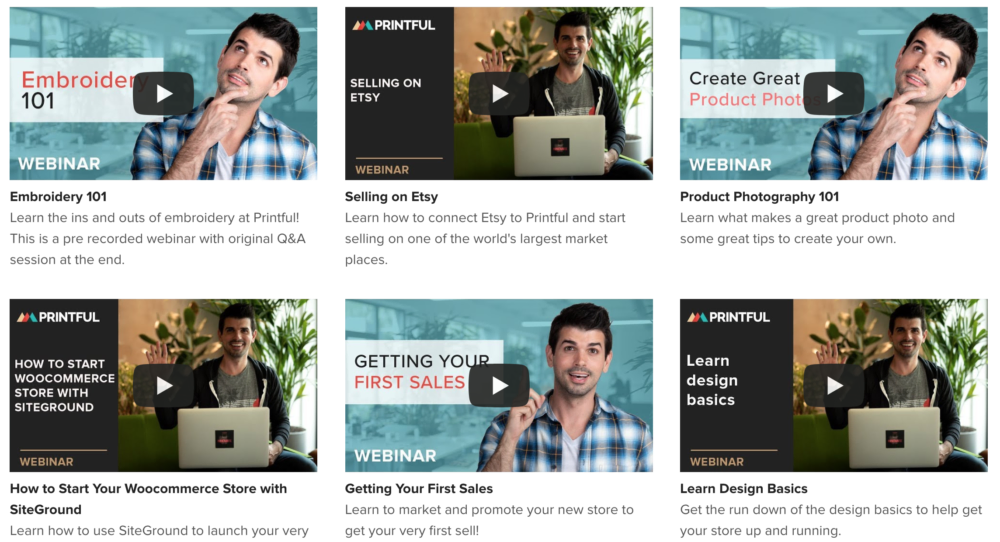
More articles on creating webinars:
#4. Lookbooks (Product Image Galleries)
For all visual markets — but especially fashion — lookbooks, or product image galleries, are a great way to “inspire” desire in a product. Lookbooks are a series of stylistic photos depicting the product, sometimes in a collage format.
Their advantage is twofold: first, the artistic nature establishes a deeper emotional connection with the shopper than basic product photos; and second, the shopper can better see the product in context.
Lookbooks Advantages
- Entertains while aiding the shopping process.
- Establishes an emotional connection with the shopper.
- Shows products used in the context.
- Strengthens brand’s reputation.
- Opens opportunity for collaboration with social influencers.
- Material for social media.
- Improves SEO for image searches.
Lookbooks Challenges
- You need to create high quality images of the product.
- It is suitable for visual products, especially in the fashion niche.
Lookbooks Best Practices
- Create an experience. Lookbooks work because they enhance the shopping experience. Play into this by designing your lookbook in the right style and tone that your shoppers are looking for (i.e., nightclub scene for sexy dresses, or friends at a park for youthful casual wear).
- The showcase featured products. You can give specific products extra attention by featuring them in a lookbook, especially if you’re repurposing the photos for social media.
Lookbooks Example

BB Dakota is a master of the lookbook. Their blog “Journal” features regular photoshoots of celebrities and models, shot by top-tier photographers, for content that’s as fun as it is promotional. The lookbook posts end with a Shop the Look section, which gives direct links to the featured items’ product pages.
More articles on creating lookbooks:
Another core component of any content marketing strategy is social media content. Not only do social media posts promote your brand, but they also synergize with your other content posts. A Facebook post can advertise your blog articles, and your blog article can include a Facebook call-to-action.

The style of posts can determine and strengthen your brand’s reputation; career advice makes you seem professionally valuable, while just-for-laughs posts make you seem relatable and funny. Moreover, a strong social media presence also provides social proof, boosts SEO, provides the opportunity for unique promotional campaigns — the benefits are countless.
Social Media Advantages
- Drive traffic to the main site.
- Attract new customers.
- The more personal relationship with customers.
- Boosts SEO.
- Customer research: know what types of customers your business attracts.
- Promotion for sales campaigns and events.
- Generate media coverage.
- Social proof.
- Faster response to problems or complaints.
- Increases brand loyalty.
- Match competitors’ social media presence.
- No cost.
Social Media Challenges
- If you don’t have a big followers base you need to pay for content promotion.
- You need to find the right social media network that works best for you otherwise is time-consuming.
- Not suitable for all niches.
- You need to post regularly at given intervals.
Social Media Best Practices
Engage in conversations. The upper hand that social media has over other types of content is direct interaction with customers. Sure, there are comments and reviews, but response times lag compared to the immediacy of social media.
Always engage directly with customers to take advantage of the two-way conversation. This requires more than just responding to customers’ questions or complaints — it’s also about starting conversations by posing questions to your followers.
The 70-20-10 Rule. Most professional social media marketers adhere to the 70-20-10 rule for deciding which type of content to post:
- 70%: Relevant to brand or business, but not self-promotional. For example, a camera eCommerce site could post a lot of award-winning photography, but not product pictures of their own cameras.
- 20%: Shared. Still relevant to your niche, but doesn’t originate from you. For example, you could post industry news so your followers look to you to stay up to date. Reposting others’ content is a great way to make friends, too.
- 10%: Self-promotional. Only 10% of your posts should be direct sales pitches or promoting your own goals.
No matter what, every post on social media should be 1. relevant to your industry, and 2. relevant to your follower’s interests.
Focus on the platforms with your demographics. Different social media platforms attract different demographics, so invest more in the ones with your ideal shoppers.
Here are some statistics from Jennifer Khumalo at Merrie Marketing:
- Facebook: Ages 25-54 (60% female)
- Twitter: Ages 18-29
- Pinterest: Ages 18-35 (80% female)
- YouTube: All ages
- LinkedIn: Ages 30-49
- Instagram: Ages 18-29
Campaigns that encourage user involvement. Social media opens a lot of doors for creative campaigning, as Starbucks proved with their famous White Cup Contest. Offer some incentive for users to engage with your social media, whether a coupon code for becoming a follower or a contest for publishing content with one of your products.
Lean on visuals. Social media feeds favor visuals, and posts with images get 94% more views. To step up the use of visuals in your social media posts, read these 6 tips from Donna Moritz at Socially Sorted.
Don’t underestimate Instagram. Instagram works especially well with eCommerce as a means to promote both the brand and individual products.
Use a posting tool. Knowing when to post is a skill by itself, not to mention there’s always a risk of forgetting. Tools like Buffer or Edgar helping schedule and post for you, so nothing slips through the cracks. All you have to do is input your own posts, and they’ll publish them on their own.
Example

Given GoPro’s product line, almost all of its social media content is videos. Their YouTube channel has several successful subchannels divided by subject, including extreme sports, American football, animals, and even their own user-submitted award selections to promote engagement.
More articles on creating content for social media:
#6. Videos
The Guardian once wrote: “Video is the future of content marketing. That is, if it’s not the here and now.” Their bold claim was backed by Cisco, whose research proclaimed that videos will account for 69% of all consumer internet traffic by 2017.
Modern and highly visual, video content has a reach, unlike any other content. It’s incredibly flexible in subject matter, style, and length, making them suitable for virtually any marketing goals or industry. How-to guides, regular series, product videos, even cat videos can all give your brand the benefits it needs.
Videos Advantages
- Attract new business.
- Strengthen bonds with existing customers.
- Deeper emotional bonds.
- Can be repurposed on a variety of platforms.
- Shows products in action.
- Flexible.
- Easily shareable on social media.
Videos Challenges
- You need quality video equipment to create them (lights, camera, microphone, video editing software)
- There is a lot of time involved to research what your audience wants (length, angle, level of information etc)
- Quite difficult to grow an audience.
- Creating quality videos is costly.
Videos Best Practices
Product videos. Regardless of your overall content marketing strategy, every eCommerce site should have product videos. The statistics are overwhelmingly positive:
- 73% more shoppers will buy after watching a video.
- 71% of shoppers believe videos explain products better.
- 58% of shoppers view companies with product videos as more trustworthy.
For more advice on product videos, read our previous post Why Serious eCommerce Brands Need a Content Strategy.
How-to videos. How-to guides establish your brand as an authority, no matter if they’re written or filmed. Some procedures are just explained better on video than in text, and some audiences (such as younger groups) prefer videos.
Include a transcript. Because search engines aren’t yet as skilled at handling video as text, including a transcript of your video boosts your SEO. Plus, it appeals to some users who prefer reading to watching.
Videos for eCommerce Example
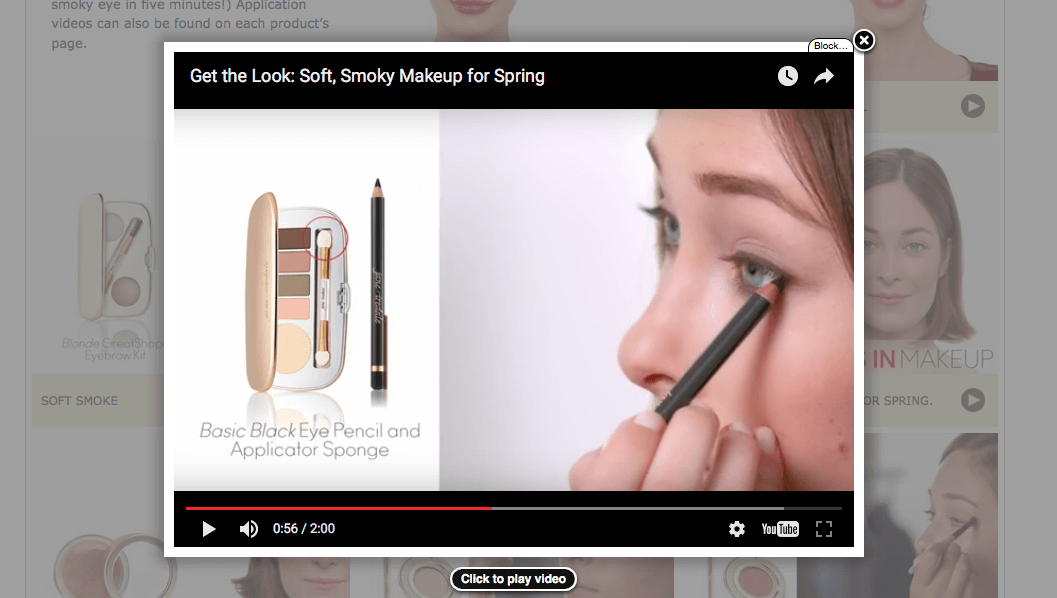
Makeup is, of course, an industry steeped in visuals. That’s why the cosmetic website Jane Iredale has an entire page of makeup video tutorials. This is a sought-after topic for loyal and new customers alike, and the site brings in new traffic simply by providing resources people are searching for.

More often than not, each video gives the brand a chance to feature specific products, which are highlighted in a split-screen next to the action.
#7. Podcasts
Podcasts are just another way to offer your expertise to your target audience, just like blogs or infographics. But the important thing to remember is that different people have different preferences — some prefer to reading, others prefer listening. You don’t have to choose between visual, textual, and audio content; it’s better to have them all to attract all types of shoppers.
Think of podcasts as an episodic variation of talk radio. A podcast for an eCommerce site might feature a charismatic host discussing industry news or topics, or interviewing relevant guests, in periodic instalments.
Not only are podcasts becoming increasingly popular each year, but marketers are investing more in this format due to their unique audience: studies show podcast listeners tend to be well-educated and also use social media more.
Podcasts Advantages
- Establishes you as an authority.
- Targets a specific type of customer with an affinity for social sharing and greater income.
- Repeat traffic anticipating new episodes.
Podcasts Challenges
- You need quality audio equipment to create them (microphone, audio editing software)
- Coordinate the recording schedules
- Consistency is key, you have to stay on track with publishing
- Quite difficult to grow an audience.
Podcasts Best Practices
Right equipment. The content of your podcast won’t matter if your microphone makes it indecipherable. You don’t need to break the bank for a sufficient microphone, as long as you shop wisely.
Structure of each episode. Structuring a podcast is a little more difficult than other types of content because most people don’t have the experience with audio programming than, say, writing an article. Stephanie Ciccarelli of Voices.com prescribes this outline for a standard 20-minute form:
- 30-60 sec.: Specific show intro — who you are and what this episode is about.
- 30-60 sec.: Show jingle or theme song.
- 3 min.: Topic 1
- 3 min.: Topic 2
- 30 sec.: Interlude (music, advertisement, etc.)
- 3 min.: Topic 3
- 3 min.: Topic 4
- 2 min.: Closing remarks — thank yous and a preview of next episode.
- 2 min.: Closing jingle or theme song.
Not all podcasts should be 20 minutes. The ideal length depends on the subject matter, the audience, and the frequency of your posts.
Trial runs. Especially if you have no experience in radio or public speaking, you’ll want to do a few trial runs before launching your first podcast. This will help you solidify your style and tone, plus knock out any technical kinks.
Submit to iTunes. iTunes is one of the best ways to get your podcast heard. Read these guidance suggestions from iTunes itself to make sure your podcast is suitable for submission.
Include a transcript. To increase your SEO and appeal to shoppers who prefer reading and browsing over the commitment of listening, include a transcript of each episode within the post. For a fee, a service like Transcribe Team can handle this for you.
Podcasts Example
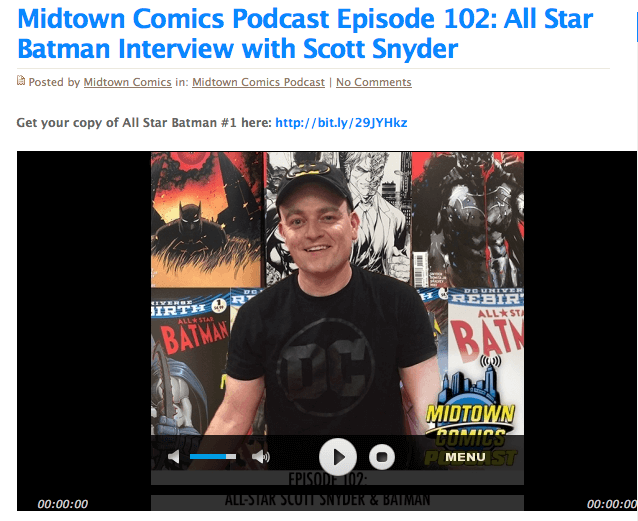
By selling a product that’s also periodical — not to mention highly debatable — Midtown Comics will never run out of topics for their podcasts. Each week they discuss the new comic releases and sometimes bring on writers and artists to join the discussion, with the comics they discuss available to buy on their site. Notice the link directly above the podcast to the Batman comic they’re discussing in this episode.
#8. Infographics
Since they first started receiving attention around 2010, infographics have steadily risen in popularity. Their usefulness lies in expressing complex data in a manner that’s fast, processible, and even fun. They also benefit the companies that make them: on average, businesses that market with infographics see a 12% traffic increase.
More than just a visual aid, infographics make otherwise bland data like statistics into something entertaining and easier-to-digest. Their potential affords them a degree of creativity in addition to providing genuinely useful information. On top of that, they’re easy to share and go viral, making them a nice addition to the right brands’ content strategy.
Infographics Advantages
- Provides customers with the information they need.
- Establishes you as an authority.
- Easily shareable and embeddable.
- Increases new traffic and brand recognition.
Infographics Challenges
- You have to choose a trendy topic.
- Promoting an infographic is quite difficult nowadays.
Infographics Best Practices
Narrative flow. The beauty of infographics is they’re more entertaining than just citing facts and data. Design yours with a coherent narrative flow, for example, divide it into topical sections that each build on the previous one.
Promote it. Your infographic will require an extra push to get it passed around and shared. Neil Patel gives some suggestions to get your infographic viral:
- SEO-laden release post
- Structured social media releases
- Manual outreach to influencers and key players in your industry
- Submit your infographic to directories: Infographics Archive, Daily Infographic, Infographics Showcase
Use time-saving tools. You don’t need to be a Photoshop expert to create an effective infographic. These 10 free tools let you make visually stunning infographics using a template- and generator-style time-savers.
Infographics Example
The bridal eCommerce store Weddington Way handles infographics smartly. They target a relevant topic that many of their shoppers — especially men planning to propose — have questions about. Even though they don’t sell diamond rings, this infographic still attracts the attention of their target clientele: people planning weddings.
More articles on creating and promoting infographics:
#9 Expert Roundups for eCommerce
An expert roundup post is a type of blog post that features contributions by multiple experts in your niche. The most effective roundups pose a very specific question that the experts can easily respond to.
When done correctly, expert roundup posts can really help you and your blog stand out. Above all else, they can provide a ton of value to your readers and blog followers.
Now will have an amazing piece of content that you, the experts, and your audience will love – and will love to share. They do take time to put together, but they’re so worth your time. You will also have made new, influential connections in your niche.
When you’re starting out, writing great content isn’t enough to get noticed. Use expert roundups to make yourself noticed and establish great relations with folks in your niche.
Expert Roundups Advantages
- Establish yourself within the blogging community in your niche
- Get a lot of targeted traffic.
- Earn good quality, targeted backlinks.
- Improves your SEO rankings.
- Establish relationships with blogging influencers in your niche.
Expert Roundups Challenges
- It takes a lot of time to create and promote a successful expert roundup.
- If you are new on the market, the experts may be reluctant to participate.
Expert Roundups Best Practices
Choose a good topic – The first thing you need to figure out is what topic and question to focus on for your roundup. Questions that focus on solutions to specific problems, software tools to solve a problem, or tips and tactics are great directions to go when creating a roundup. Whatever topic you choose, you want to make it as easy as possible for your experts to answer the question.
Create a list of experts in your niche – There are several places where you can find experts in your niche: Social media networks, Google and tools like Outreach.buzz, SEMrush and NinjaOutreach. The experts you will contact will most likely reply back and will like to participate in your expert roundup if they know you or your website have a lot of traffic and authority. If you’re new, prepare yourself for a lot of rejection or silence from their end.
Find experts willing to participate in the expert roundup in your Skype and business cards, contacts list, your connections in your niche, on social media etc. Linkedin is hot nowadays, use it to your advantage.
After you have the expert roundup ready, spend time promoting it to your contacts and to the press. Also, inform all the participants so they will promote it to their audience. That’s mandatory for your expert roundup success.
Check our step by step complete guide on how to create a successful expert roundup.

Expert roundup for eCommerce Example
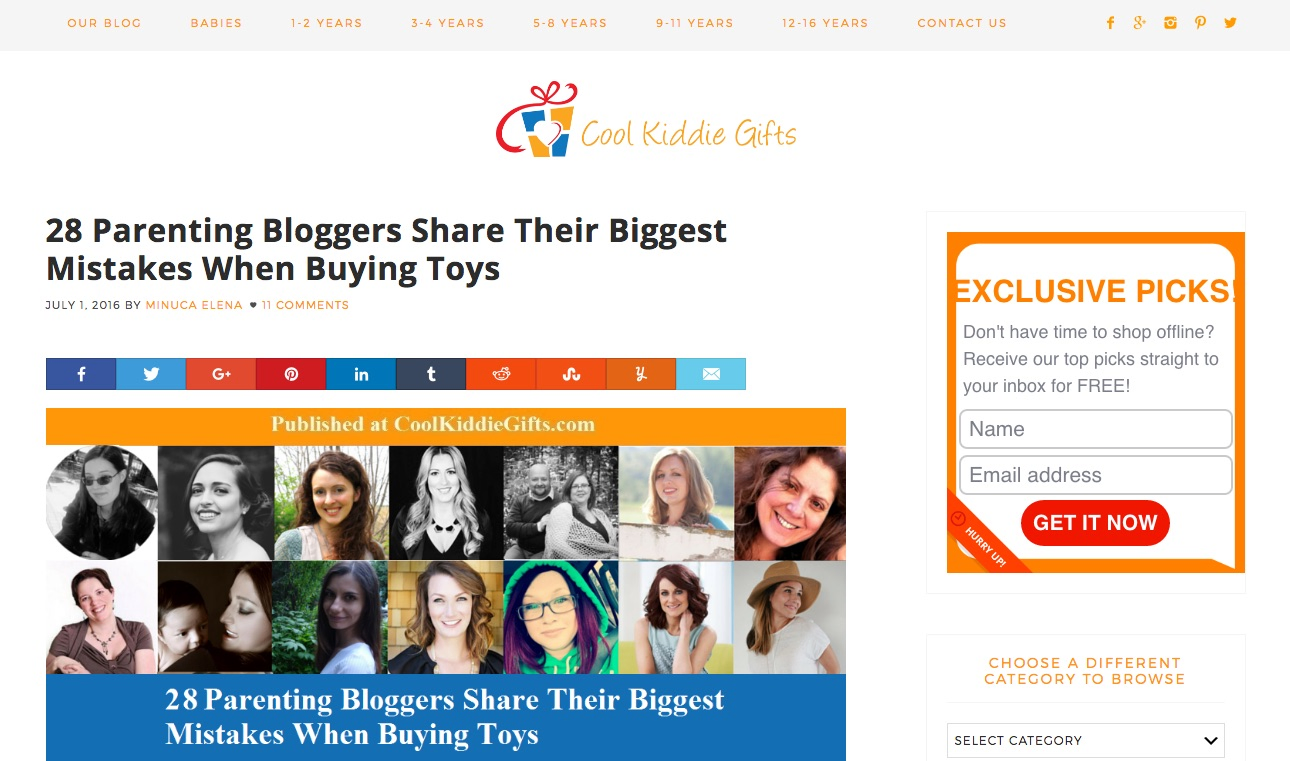
Mommy and parenting bloggers won’t have a massive reach or following, the following that they do have is usually quite loyal. The same holds true for many of the shopping and coupon bloggers out there as well. When they aren’t saving money or dishing the dirt on the latest parenting tips, you might just find some of them on parenting expert roundups like this one.
More articles on creating and promoting expert roundups:
#10. Email Marketing
While a little different than the other types of content marketing on this list, email marketing is still a worthwhile avenue — especially for eCommerce, where it accounted for over 7% of customer acquisition in 2013. Moreover, 33% of consumers cite email as their biggest influence in online spending.
Email serves a variety of purposes. For starters, it can be a source of communicating directly to your shoppers about new deals or campaigns, even with personalized recommendations. A newsletter with broader range keeps your entire customer base informed on periodic updates and can entice sales through speciality coupons.
At a more advanced level, emails can even be used to collect customer data; for example, you can email a shopper about why they abandoned their cart to improve your site design in the future.
Email Marketing Advantages
- Direct communication with the shopper
- Customer segmentation for more accurate targeting
- High personalization levels
- Customizable for different stages of a sales funnel
- Low cost
- Synchronized to other channels, like your blog and social media
Email Marketing Challenges
- You need an an email list. Don’t have one? Start ASAP.
- Needs a lot of A/B testing to personalize and find converting subject lines, content, CTAs.
- Need quality email sending software and to follow email best practice otherwise your emails will end up in the Junk folder.
Email Marketing Best Practices
Subject line. Statistically, the subject line has the greatest impact on the success of an email marketing campaign. There are a lot of intricacies to consider when composing a subject line, so read John McIntyre’s piece at the Digital Marketer for a thorough treatment.
Personalization. Take advantage of email’s capability for personalization. For example, look at what the customer has bought in the past and customize their recommendations. Some areas to look into for speaking to specific customers:
- Products browsed and purchased
- Usual price ranges
- Frequently visited categories
- Geographic location
- Date of last order
- Age
Transactional “series” emails. As opposed to the direct emails that are sent to everyone, transactional emails are sent only when triggered by a customer’s action (or lack thereof). These types of emails are also personalized, and therefore more effective. Crush Campaigns recommends these 4 series campaigns:
- Welcome — Whenever a new customer registers or signs up for a newsletter, send them a welcome letter thanking them and reiterating the advantages.
- Follow Up — One of the most important types of emails, a follow-up after a purchase is the perfect opportunity to elicit the ever-so-valuable product reviews and ratings. Try to time your email around the time of the product’s delivery, when their excitement is at its height.
- Abandoned Cart — If the user has placed an item in the cart and then abandoned it, send a friendly reminder as a way to encourage a sale, or use the chance to collect user data about why they decided against buying.
- We Miss You — When a customer hasn’t bought anything in a while, try to entice them with a special coupon, free shipping, or personalized recommendations for new products.

Playing into the Pokemon Go trend and the knowledge that most of their customers are likely gamers, Firebox’s timely Pikachu-themed email offers to solve Pokemon Go player’s number one problem: the game drains their phone battery.
After grabbing the reader’s attention with a colourful representation of the game’s iconic character, the email offers battery chargers to solve the user’s biggest problem without them even asking.
More articles on email marketing:
#11 Interactive content: Quizzes, Polls
Because of its ability to engage audiences, drive revenue and generate leads, the quiz has become the answer that was under the radar all the time.
There are mainly two types of quizzes you can create:
- The Personality Quiz – The “self-serving bias” makes it so that people love hearing good things about themselves. This type of quiz categorizes people into different personality types based on their answers.
- The Knowledge Test – Have you ever wondered how much you know about a given subject? That’s where the knowledge test comes in. This quiz can also be used as an assessment to see how much someone knows about oh, let’s say, your brand for example.
Create a quiz with personalized results for each individual customer so that you can offer product suggestions specific to that person. This can be done by either recommending one specific product or by assigning people a “personality” that relates to a group of products. Make sure you follow up with marketing automation to keep your customers coming back for more down the road.
Quizzes Advantages
- Ever-green type of content
- Attract and engage audiences
- Increase traffic through social share.
- Generate leads.
- Strengthens brand’s reputation.
Quizzes Challenges
- You need to research an entertaining topic for your quiz.
- You may need to promote it initially to offer it traction.
Quizzes Best Practices
- Connect With Your Audience – We can’t emphasize this enough. Connect with your audience on a more personal level. Approach your audience as if you were talking to them in person. This helps establish a more relaxed tone, which will help when it comes to your audience opting in later on.
- Provide Visual Stimulation – There’s nothing wrong with having text-only questions, but it’s nice to switch things up every now and then by including images. The use of images in your questions still keeps things relevant while adding a level of fun to your quiz. Using images can turn a boring old quiz into a trivia game, so try it from that angle.
- Keep Things Short And Simple – People’s attention spans today aren’t as good as they used to be. That’s why it’s a good idea to aim between having 6 to 8 questions in your quiz. On average, it usually takes someone about 2-3 minutes to finish their quiz.
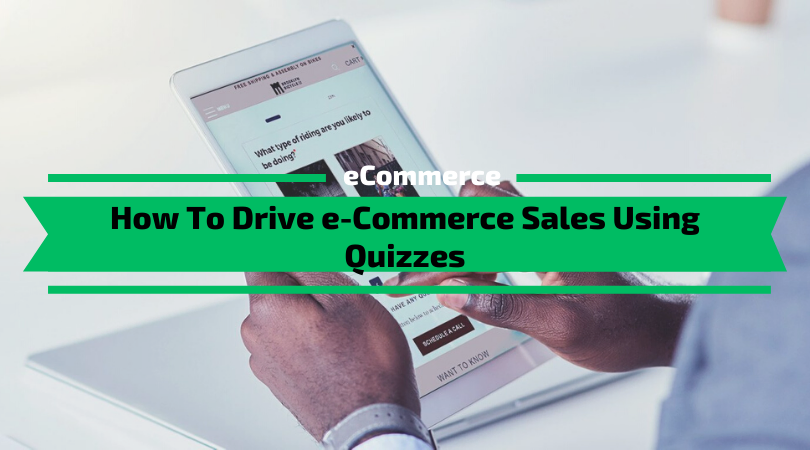
Quiz for eCommerce Example

More articles on creating and promoting expert roundups:
#12. FAQ pages
In these busy times, people are looking for fast, exact answers to the questions they may have. This is true also in the e-Commerce niche. Creating a FAQ page or multiple FAQ pages for your product categories will help you get more visitors and links.
On the other hand, will help you increase sales as it will reduce the friction on buying and keep your current customers happy as they find the answers they are looking for on your website.
FAQ pages Advantages
- Reduce purchasing friction as the user find answers to their questions.
- Reduce support load as a user find answers to their questions after purchase.
- Increase authority as it proves you know your products and your niche.
- Increase traffic through SEO.
- Get you link as people will link to the answer.
FAQ Pages Challenges
- You need to research the most asked questions online and on your support desk.
- You need to spend time to write detailed correct answers to these questions.
- Spend time keeping the FAQ pages updates with the changes of your product or your niche.
FAQ Pages Best Practices
- Write down twenty frequently asked (FAQs) questions about your niche right now.
- Look for suggesting searches in Google, the questions people ask on platforms such as Quora and Yahoo! Answers, and play around with tools like AnswerThePublic.com.
- Prioritize them according to search volume and start writing.
- Categorize the FAQs to give visitors an easy way to navigate around them.
- You can even include visuals, videos, and links explaining the topic.
- Add FAQ schema markup to your page so the answers will appear in Google searches.
FAQs page for eCommerce Example
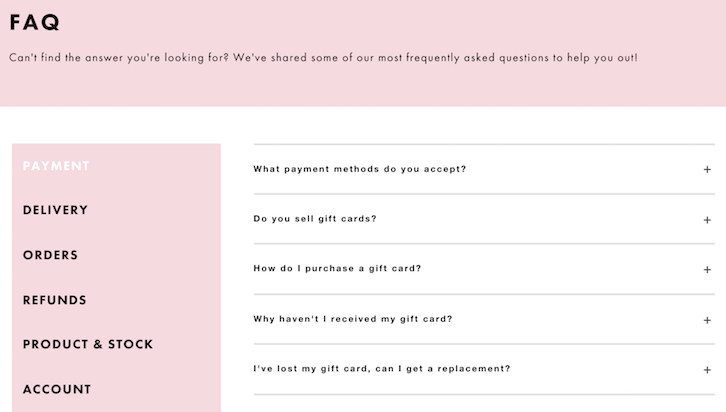
#13. Glossaries & Dictionaries
The dictionary approach is very similar to the FAQs, it’s just a different content type. Instead to answer to questions your readers may have you explain the key terms from your niche.
This approach is quite underrated as most eCommerce owners concentrate on selling and the products but they forget the clients that are new and don’t know the terminology.
Creating a glossary increases your sales, reduce the support load and increase your brand, authority. On top of that may land you several backlinks.
Glossary Advantages
- Reduce the support load on presale questions.
- Increase your sales.
- Increase your authority and your brand in your industry.
- Reduce the bounce rate.
Glossary Challenges
- You spend time to research and organize the key terms in your niche.
- You need to give the exact and correct explanation otherwise the things will backfire. (You will be seen like an amateur not an authority in your niche)
Glossary Best Practices
- Make a list of the most used key terms in your niche
- Do your own research, write the description, double-check with an expert to make sure everything is correct.
- Categorize the dictionary terms.
- You may prioritize the dictionary terms according to search volume and start with the ones with most search volume.
- Include visuals, videos and links.
- Don’t forget to Link from the dictionary terms to product category pages and product pages.
Glossary Example
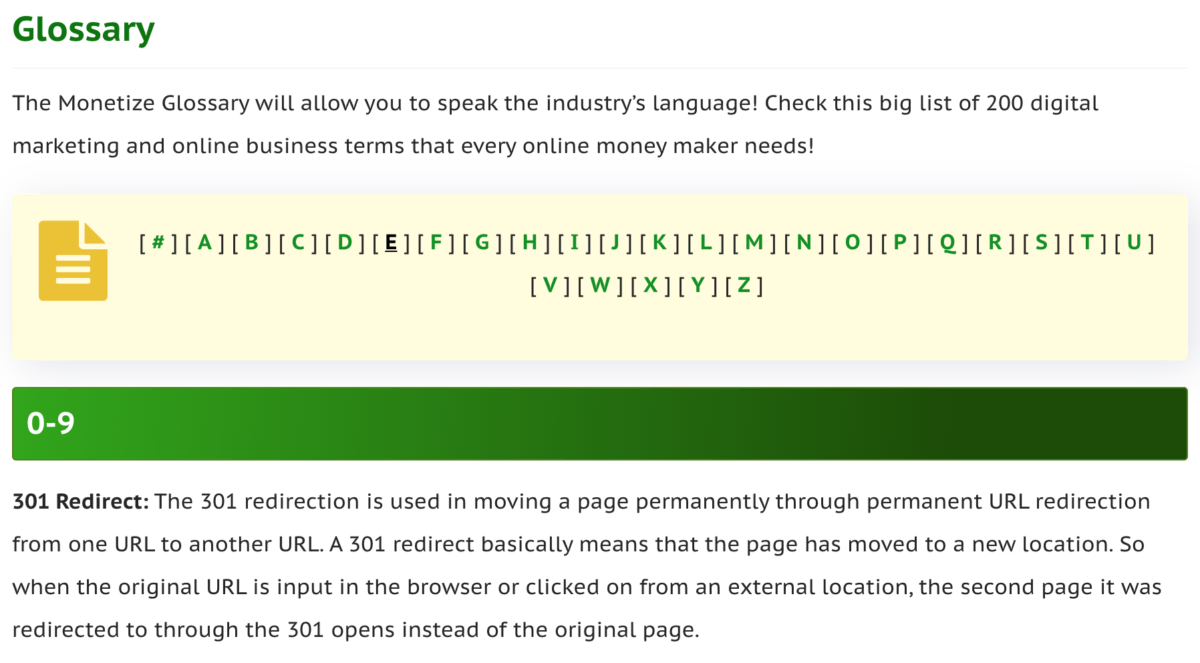
More articles on creating glossaries for eCommerce:
#14. User-generated content
Till now I’ve shown you content types you, as a business owner, could create. However, now we will look into UGC – user-generated content which means content created by your customers or followers.
UGC is essentially word-of-mouth at scale in the modern internet era. It has allowed users to connect with other users en masse. compressing space and time.
For e-commerce, utilizing UGC is the embodiment of the good old quote “killing two birds with one stone.” Your business get’s free content while simultaneously engaging with the customer and building a community.
In e-commerce, UGC can take many forms: customer reviews, product photos and videos, questions on forums or social media, blog posts, hashtag challenges, etc.
User-generated content Advantages
- Leverage content created by your customers.
- Engage your customers and build a community.
- Free marketing for your e-commerce business.
- Create strong social proof for your store.
User-generated content Challenges
- Doesn’t work if you don’t have enough customers.
- Need time and resources to monitor the internet for UGC.
- Quality content needs oversight. You need to curate the content and ignore SPAM.
User-generated Content Best Practices
Always request permission – A branded hashtag is a great way to collect user-generated content. However, it’s a good idea to ask for permission even when a post includes your tag. Re-sharing that content without explicit permission is a surefire way to kill goodwill and annoy some of your best brand advocates.
Offer something of value in return – A social media contest can be a great way to bring in a substantial amount of UGC quickly. Don’t get too focused on rewarding UGC creators with prizes. One survey found that only 32% of consumers created and shared UGC because they wanted to win a prize. Instead, 60% said they shared UGC to get more likes or to have their content featured by a major brand.
Use search streams to find user-generated content you might have missed – If you focus on collecting user-generated content only when users tag you or use your branded hashtag, you’re missing out on tons of potential content. As part of your social listening program, you should be keeping an eye out for all mentions of your brand or your products on social media, even if you’re not tagged.
Example
It’s all about creating trust. A full 92 percent of consumers trust recommendations from people they know, and 70 percent trust online consumer opinions. Burt’s Bees shares customer testimonials about their products along with UGC on Instagram. This helps to boost, followers’ trust in the products and the brand.
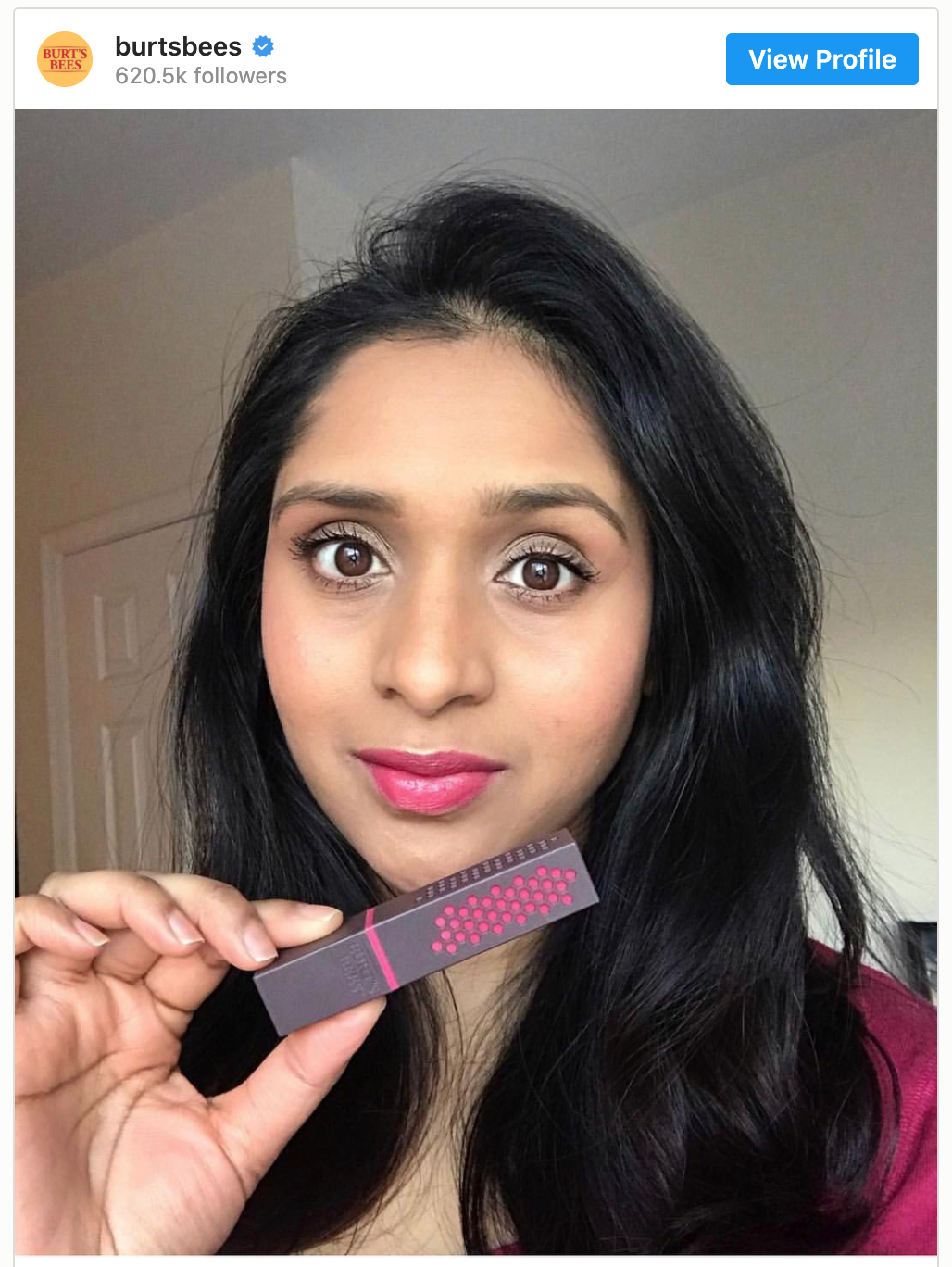
Conclusion
Are there any specific types of content you’d like to know more about that weren’t listed here?
Mention them in the comments and we’ll include some information about them in future posts.
 Monetize.info We Help You Grow & Monetize Your Online Business!
Monetize.info We Help You Grow & Monetize Your Online Business!

![Content Types To Create for eCommerce [Complete Guide]](https://monetize.info/wp-content/uploads/2020/06/Content-Types-To-Create-for-eCommerce-Complete-Guide.webp)




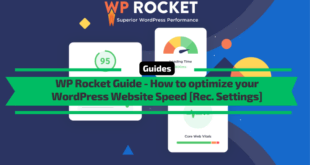

I love this post, this is really great
Case studies are a great way to showcase the success of your products or services. They can be used to demonstrate the benefits of your products, and they can also help you build credibility with potential customers.